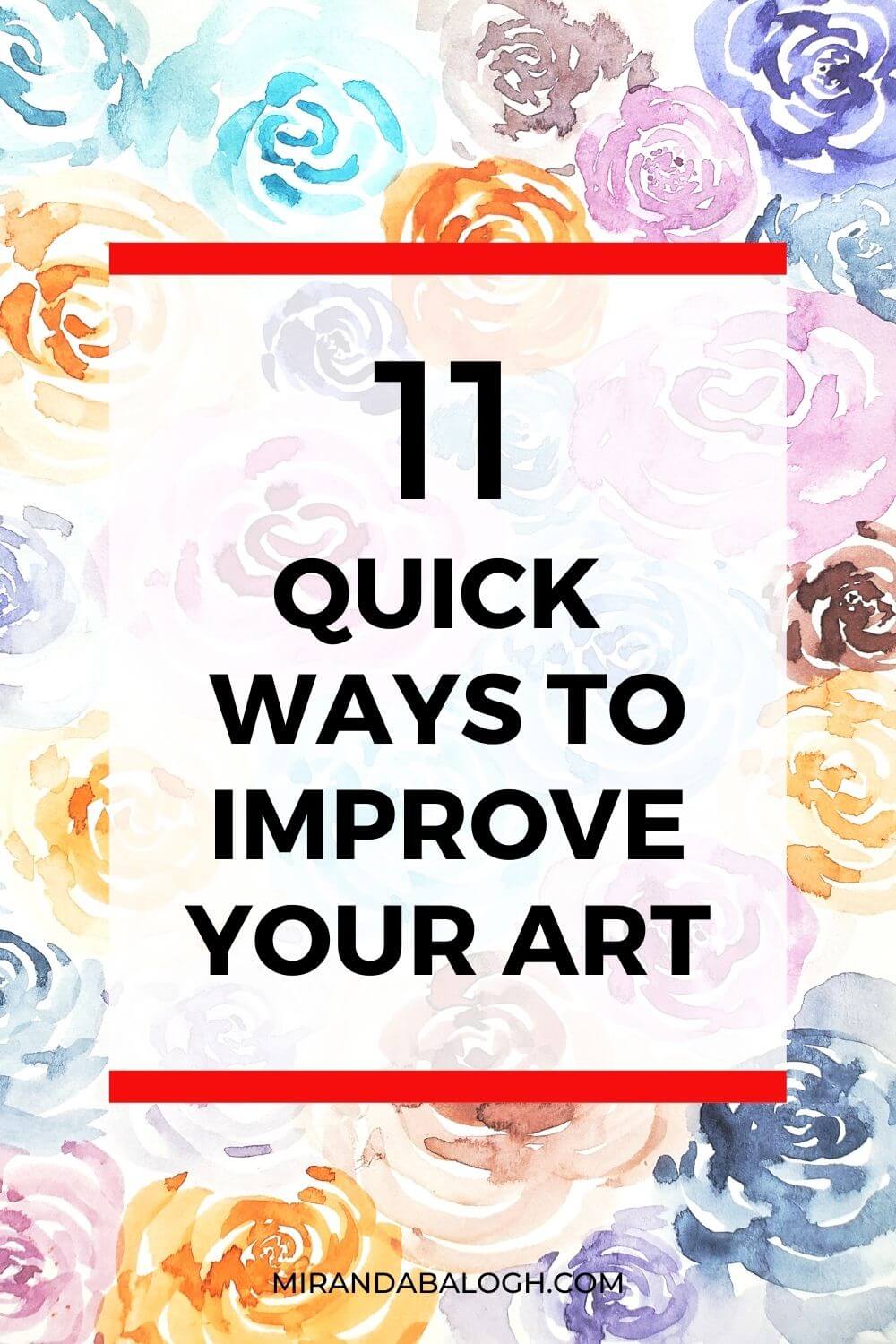The daily life of an artist is pretty busy.
However, many creative individuals struggle with managing their time because they’ve learned how to be busy rather than productive.
For this reason, it’s crucial to learn how to implement time management for artists so you don’t end up stressed or burned out.
That’s why, in this article, you’ll learn about effective time management tips such as:
- Goal setting for artists
- Prioritizing daily tasks
- Determining priority of tasks
- Batch working
- Getting into a creative work flow
- No more multi-tasking
- Using a calendar or planner
- Automation
- Sticking to effective routines
Before you know it, these simple changes to your daily routine will improve your creative output while decreasing daily stress.
Table of Contents
What is Time Management?
First of all, what is time management’s definition?
Simply put, time management is the process of planning and organizing tasks in order to increase efficiency and improve overall productivity.
By effectively managing one’s time, it becomes easier to achieve your goals at a faster pace and in an easier manner.
For these reasons, it’s essential for you, as an artist, to learn how to implement time management tips so that you can more easily manage your workload.
For instance, one of the best examples is finding time to make art as a busy artist.
But, with strong time management and organization skills, this task becomes easier to accomplish because you know which tasks to prioritize and work on as a creative individual.
Why Is This Skill Important?
Time management is an important skill to learn because it helps you maximize the time you dedicate to tasks. By doing so, you are able to:
- Get more work done in a shorter amount of time
- Reach your goals faster and more easily
- Develop routines that are conducive to your business, career, etc.
- Reduce stress by freeing up time to focus on yourself
Developing strong time management skills for artists is crucial in order to ensure that you’re spending your time wisely on the tasks that will give you the best returns on the time investment you have made.
1. Set Achievable Art Goals
One of the best time management for artists tips is to begin with goal setting.
Just like practicing positive daily affirmations, goal setting is a powerful strategy that improves your habits by training your mind to focus on results-driven goals.
After all, how can you successfully manage your time if you don’t even know what you want to accomplish within a specific time period?
So, grab a journal or open a Word document to get yourself started.
First, you’re going to create a few categories in which you will write down your desired goals. Example categories include:
- Work/professional goals
- Personal goals
- Business/entrepreneurial goals
- Learning goals
- Miscellaneous goals
Second, after you’ve identified a few categories, I want you to do some brainstorming. Start off by asking yourself this:
What are the most important goals that I need to accomplish in each category?
Write down the goals that you come up with and make sure they’re sorted into their appropriate groups.
SMART Goals
Third, you’re going to write SMART goals.
Wait a minute!
What are SMART goals? Essentially, it’s an acronym that stands for:
Specific Measurable Attainable Realistic Timely
SMART goals are great because they give you direction to help you realize your goals.
For example, let’s say your goal is to write many blog posts this month to promote your creative business.
That’s quite vague. Instead, you should consider being more intentional when defining your goals. Break down each goal as follows:
- Specific: I will curate good content for my blog by focusing on _____ and _____. (Insert your topics here)
- Measurable: Every week, I will write 2 blog posts for a combined total of 8 blogs per month.
- Attainable: Ask yourself if you have the appropriate resources to accomplish this goal.
- Realistic: Ask yourself if you have set aside enough time each week to realistically write, edit, and publish 2 blog posts.
- Timely: Determine the 2 days when you will post each blog on your website every week.
When you approach your goals with intentionality, they become easier to achieve because you’ve designed a map to reach that goal.
Without a map, it’s harder to evaluate whether you’re putting time and effort into the right actions that will help you achieve those goals.

2. Prioritize Daily Tasks
One of the best ways to learn how to get organized as an artist is to learn how to prioritize your day.
Now, this time management strategy can be a little bit tricky because you need to be honest with yourself when it comes to acknowledging which tasks are truly more important than others.
You must do this because it’s imperative that you recognize which tasks will get you results faster and more effectively.
Note: If you skip this important step, you might end up wasting your time on tasks of lesser importance. This will slow you down or distract you from actually getting any meaningful work done.
For example, if you’re a creative entrepreneur, you’ll need to decide which tasks will move the needle for your business and prioritize them.
So, do you focus more time on writing blogs or marketing them? In the Instagram vs Pinterest debate, should you spend more time designing and marketing your pins or community-building on Instagram?
3. Make a To Do List
But what’s the most effective way to do this? Start by:
- Writing down your tasks in a journal or typing them out in an organization app such as Trello
- Create a list of everything you need to complete for the day/week
- Observe the tasks on your list and decide which ones are of the most importance, and which tasks are of lesser importance
Once you have determined which tasks are essential and non-essential, rearrange those tasks in order from the highest to lowest priority.
Note: If your list seems long, you can reduce overwhelm by selecting the 3 most important tasks of the day and only focusing on those before moving on to everything else.
In this book, Stephen Covey (the author) goes into great detail on prioritization by divvying up tasks according to their level of urgency.
4. Batch Work to Save Time
You might be wondering: How many hours a day do artists worK?
Well, that depends entirely on the individual’s workload and tasks. But if you want to maximize your time as an artist, you should consider batch working.
If you’re new to this concept, let me explain it:
Batch working is when you group similar tasks together in order to complete them all at once.
For example, let’s say you’re you’re planning new projects, marketing your work, and managing administrative tasks in your business.
Instead of setting aside time to do a little bit of each task every day, it’s much more effective for you to focus on one task and do a large amount of work in one specific area.
For example, if you haven’t done so already, incorporate batch working into your social media marketing strategy so that you can create and schedule your content all at once. This will reduce overwhelm and stress.
5. Get into a Creative Work Flow
Slipping into a work flow is the ultimate goal when batch working.
A creative work flow is a process of steps that help an individual or a business get work done in an efficient manner.
When you are really focused on a specific task, you’re able to fall into a steady flow state. This is when you are very focused on something to the point where you are free of distraction.
As a result, the end product often ends up being of much higher quality than if you completed each task individually.
But why is this?
Research has proven that the most efficient workers are able to produce top quality work when they enter a flow state. Refer to this article by Verywellmind.com for more information about the psychology behind flow states.
So instead of compartmentalizing each task, it’s better to paint several paintings at once, write multiple blog posts, or complete several collaborations at once.
6. Stop Multi-Tasking
In terms of time management for artists, I personally believe that multi-tasking is not an effective strategy that will increase your productivity.
Task-switching requires you to constantly change between different tasks. This prevents you from slipping into a steady workflow.
When this happens, it becomes all too easy to break your focus, and you’re less likely to actually complete any tasks in their entirety.
For example, how effectively can you write sales copy, design Pinterest pins, or update your Etsy shop if you’re constantly interrupted?
Okay, so you might be wondering:
What’s the best solution?
Focus on a single task (batch working) and complete the task in its entirety and to your greatest ability before switching to another job.
After all, it’s better to complete fewer tasks at a high, professional calibre than it is to complete more tasks at a lower, incomplete calibre.
7. Use a Calendar or Planner
This time management tip for artists will help you learn how to make an art schedule that you’ll actually stick to.
Using a calendar or a planner to organize your work is one of the smartest ways you can leverage your time wisely.
Note: Personally, I like the use Google Calendar because it is a free program that allows you to easily plan out your day/week/month.
How you decide to set up your calendar is entirely up to you. However, here are a few time management tips that can help you get started:
- Create colour-coded calendars such as 1 calendar for work, personal, hobbies, business, etc.
- Pick specific days to complete specific tasks
- For example, you might take care of administration on Mondays, write copy on Wednesdays, and film on Fridays
- Customize calendar entries so that certain tasks are repeated on a consistent basis
- Make use of the Tasks option on the right side of the screen
- Download the app on your computer as well as your smartphone so that you can access it anytime and anywhere
It’s fairly intuitive to use, and—if you’re a creative individual like me—you’ll appreciate that you can colour code your tasks to make visually appealing and easier to read at quick glance.
You’d be amazed by how much more effective and productive you can be when you have a calendar already mapped out for you.
No more wasting time trying to figure out what to do every day! So make sure you start implementing these time management strategies ASAP.
8. Set Up Automation
You should consider using automation to ensure that all tasks are being completed in a timely manner.
In addition, you don’t want to become bogged down or stressed out by thinking you need to handle all of your responsibilities on your own.
So, automation is a great option for those who are willing to invest in their creative pursuits, endeavours, and business.
Some examples of automation services include:
- Planoly for scheduling Instagram posts
- Virtual assistants who can manage your outsourced tasks
- Tailwind for Pinterest marketing
Although automation is not necessarily a must have for every creative, it’s definitely something to think about.
Especially if you plan to turn your creative pursuits into a legitimate business one day.
9. Time Management for Artists: Routines
All of these time management tips won’t mean much if you don’t develop a strong, consistent routine that you practice regularly.
For instance, there’s no point creating a calendar if you don’t consult it.
And there’s not much use in batch working if you get interrupted by other responsibilities, which leads to multi-tasking.
Note: At first, it may be difficult to incorporate all of these time management techniques. So just focus on 1 or 2 at the beginning.
Once they have become part of your daily habit, then move on to incorporating additional strategies to improve your overall productivity.
Soon enough, you’ll begin to see tangible improvement in your work ethic as well as in your creative output.
Lastly, don’t forget to create consistent routines that incorporate self-care into your daily schedule. This will ensure that you’re maintaining a good balance between work and play.
Conclusion
Now that you have learned about time management for artists, you’ll definitely be able to improve your productivity and efficiency.
And, as a bonus, you’ll realize that your stress will decrease because you’re more organized and effective every day.
Remember that everyone works differently, so make sure you adapt these tips to fit your personal work style.
In time, I’m sure you’ll see your creative pursuits and endeavours improve as you master your time management strategies.
Do you have a time management routine that helps boost your productivity? Share your routine in the comments below!

Miranda Balogh
Artist & Online Educator








Batch working is the BEST and this makes me more focused on the task I’m dealing with at a time. But, my problem is I don’t know how to prioritize things and it can be so overwhelming. Thank you for this post!
Agreed! Batch working has completely changed the way I work because it has helped me save so much time! And prioritizing tasks can definitely be challenging, especially if there are so many tasks that seem equally important. In these situations, I ask myself which tasks are likely to produce the best results and “move the needle”, and then I prioritize my tasks based on that criteria. Thank you for sharing!
Yes to SMART goals. Seriously, they’re the best way to goal set 💯. I also really like how you broke down the different goal types. I’m so focused on meeting business goals, I often forget to set other like personal and relationship goals.
Thanks for sharing these tips. They’re very helpful!
Thank you for taking your time to read this post! I love SMART goals because they are so structured and specific. I included the different goal types because I believe that organizing goals this way can help balance the different aspects of one’s life in a healthy manner. So I’m glad that you found these tips helpful!
These are really great tips to improve time management. I use SMART goals at my day job, but need to get better at it for my personal work. And learning to prioritize is so, so important – but not that easy! Thanks for the great suggestions.
You’re right about prioritization not being an easy thing to accomplish. But with time and practice, it’s definitely a skill that we can master to help us improve our productivity. Thanks for sharing your ideas, and I’m glad that you enjoyed these tips!
This is such an important topic for me! Sometimes I feel like I am on top of everything and sometimes just no but it is important to be consistent (even after slipping). I love some apps that help you batch work, something that I discovered only few months ago and still learning. My main issue is multi-tasking, I just have so many things open, and really working hard to stop it by just randomly closing tabs until only 1 task is open. Still very very hard!
I completely relate to the multi-tasking issue! It’s a habit I’ve stuck to for a long while, and unlearning it has been challenging. At the end of the day, all we can do is keep trying to be better and better while also staying as consistent as possible. Thank you for sharing your experience!
I love the tips! Thanks!
I recently made a bullet journal SMART Goal Setting template, and I now put every goal I set through that filter. I think it is so important to set terms and conditions for our goals. It is like built-in accountability and acceptance criteria all in one.
Agreed! After getting the idea from the book Atomic Habits by James Clear, I started setting terms and conditions to help me reach my goals and stick to my habits. It was such a game changer for my productivity!